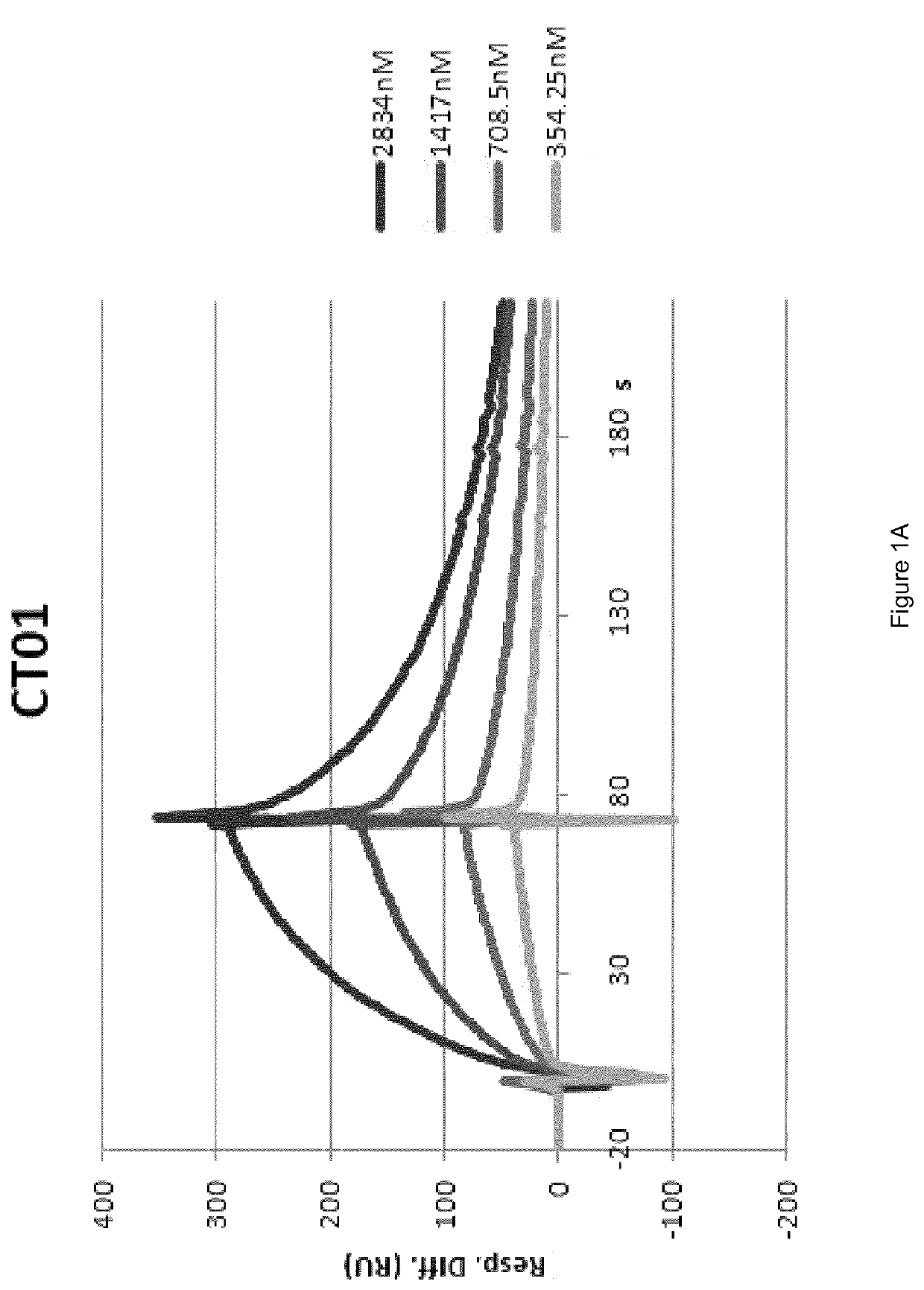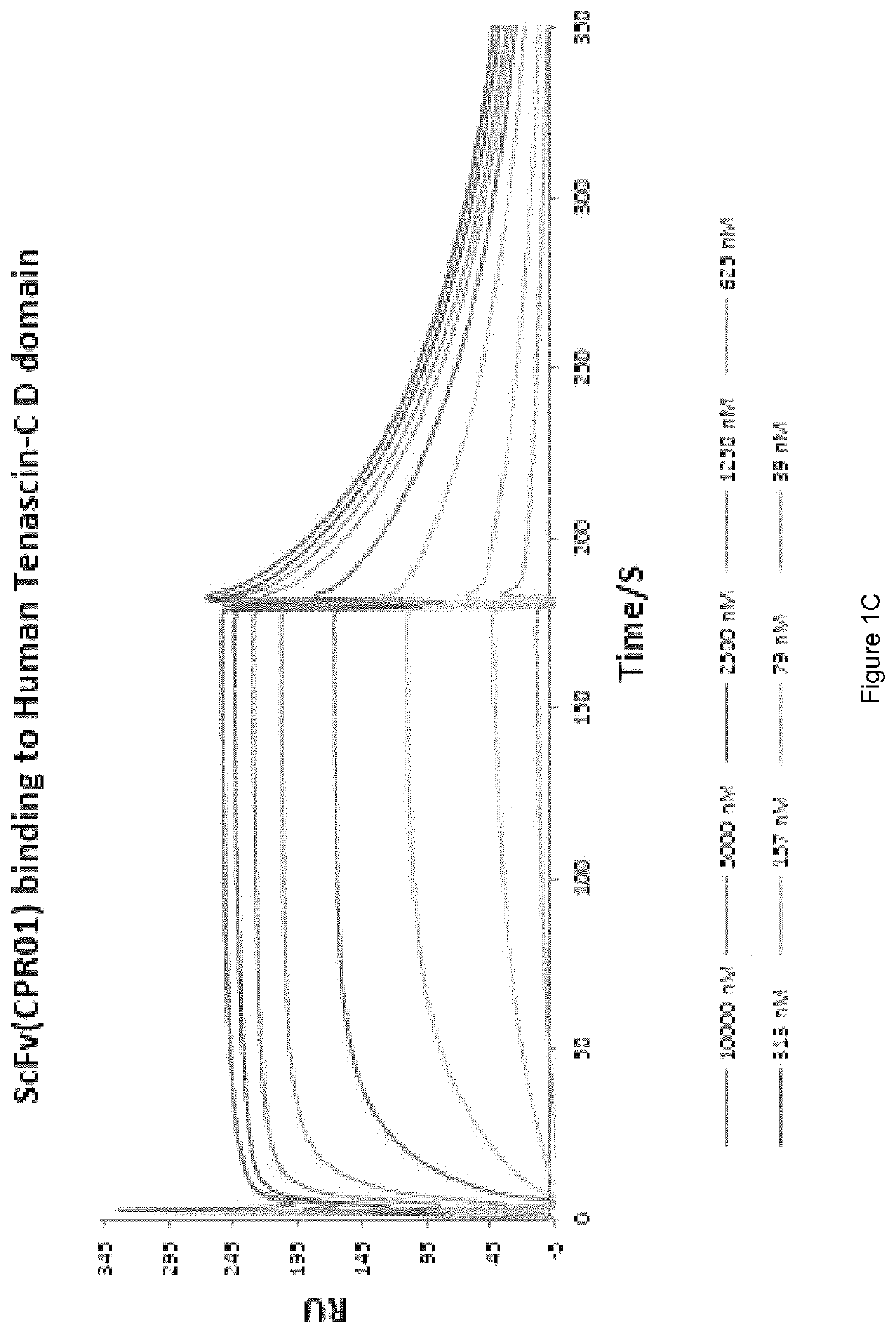Antibodies for treatment and diagnosis of inflammatory bowel disease
a technology for inflammatory bowel disease and antibodies, applied in the field of disease diagnosis and treatment, can solve the problems of not being able to fully explain the presence or role of iiics in inflammatory bowel disease, not being suitable for targeting applications, etc., and achieves the effect of facilitating production and purification and facilitating clinical-grade material
- Summary
- Abstract
- Description
- Claims
- Application Information
AI Technical Summary
Benefits of technology
Problems solved by technology
Method used
Image
Examples
example 1
Preparation and Characterisation of the Novel Antibodies CT01 against Lysozyme, FF01 and FF02 against Neutrophil Elastase, 2PC10 against TIMP-1, CPR01 and CPR01.1 against Domain D of Tenascin C
[0130]The antibodies against human lysozyme, human neutrophil elastase, human TIMP-1 and domain D of human tenascin C, antibodies CT01, FF01 and FF02, 2PC10, CPR01 and CPR01.1, were isolated in single-chain Fv (scFv) configuration from phage display libraries, which included the libraries described in PCT / EP2009 / 006487, Weber et al. (PLoS One, 2014, 9 (6) doi: 10 / 1361) and Silacci et al. (Protein Engineering Design & Selection, 2006, 19, 471-478), according to the screening technique described by Silacci et al. (Protein Engineering Design & Selection, 2006, 19, 471-478) using lysozyme, neutrophil elastase, TIMP-1, and domain D of tenascin C, respectively, as the screening antigen.
[0131]Antibodies in SIP format were prepared by fusing the VL domain sequence of the antibody in scFv format to the...
example 2
Immunofluorescence Staining of Sections from Ulcerative Colitis Patients
[0163]Freshly frozen biopsy samples of Ulcerative Colitis were stained according to published methods (S. Pfaffen. Eur J Nucl Med Mol Imaging 2010). In brief, purified biotinylated antibodies in SIP (KSF) or IgG (SW01, L19, F16, CH01, G11) format were added at the final concentration of 2pg / ml to the sections. Detection of the primary antibody was performed with streptavidine-Alexa-488 antibody (Invitrogen).
[0164]Positive control was performed by staining blood vessels with an antibody (eBioscience, 1:100) specific for CD31, an endothelial cell marker, the signal revealed with goat anti-mouse Alexa-594 (Invitrogen). Further positive control was performed by counterstaining for cell nuclei was performed with DAPI (eBioscience). Sections were mounted with fluorescent mounting medium (DAKO) followed by analysis using an Axioskop2 microscope with a 10× objective (Carl Zeiss A G, Jena, Germany). The results are shown...
example 3
Immunofluorescence Staining of HT29 Cells with the CT01 Antibody
[0165]Coverslips were placed into culture dishes (100 mm×20 mm), and HT29 cells (both human adenocarcinoma cell lines) were then seeded at 100,000 cells / mL in the culture dishes respectively. The culture was incubated until proper confluency was reached. Cells were fixed and permeabilized by ice-cold methanol incubation at −20° C. Cells were then blocked with 10% FBS / 2% BSA. Affinity-purified antibody CT01, in SIP format (final concentration 5 μg / ml) was first incubated with the cells, followed by incubation with a rabbit anti-human IgE antibody (1:500 dilution; DAKO). The antibody was then detected with goat anti-rabbit IgG Alexa 488 (1:1000 dilution; Invitrogen). DAPI was used for nuclei staining. The anti-hen egg Lysozyme SIP antibody (KSF) was used as an isotype-negative control for the staining. The results demonstrate that the anti-human lysozyme antibody CT01 is capable of staining lysozyme in biological samples ...
PUM
| Property | Measurement | Unit |
|---|---|---|
| flow rate | aaaaa | aaaaa |
| flow rate | aaaaa | aaaaa |
| concentrations | aaaaa | aaaaa |
Abstract
Description
Claims
Application Information
 Login to View More
Login to View More - R&D
- Intellectual Property
- Life Sciences
- Materials
- Tech Scout
- Unparalleled Data Quality
- Higher Quality Content
- 60% Fewer Hallucinations
Browse by: Latest US Patents, China's latest patents, Technical Efficacy Thesaurus, Application Domain, Technology Topic, Popular Technical Reports.
© 2025 PatSnap. All rights reserved.Legal|Privacy policy|Modern Slavery Act Transparency Statement|Sitemap|About US| Contact US: help@patsnap.com



